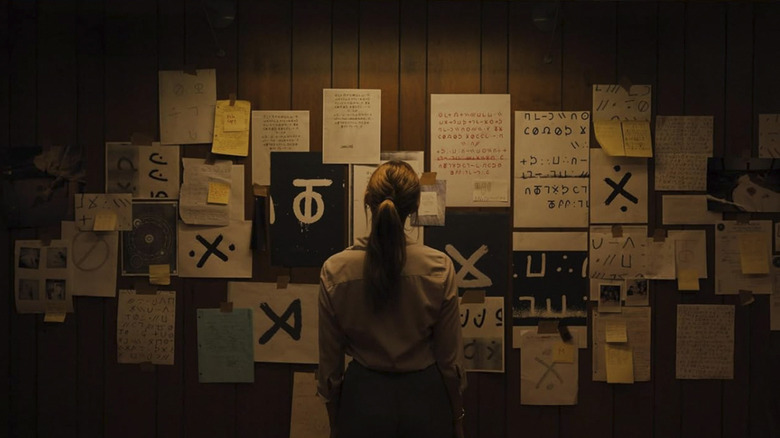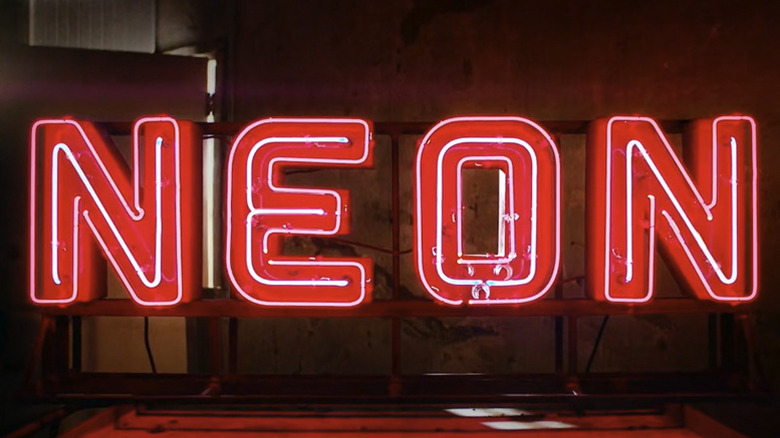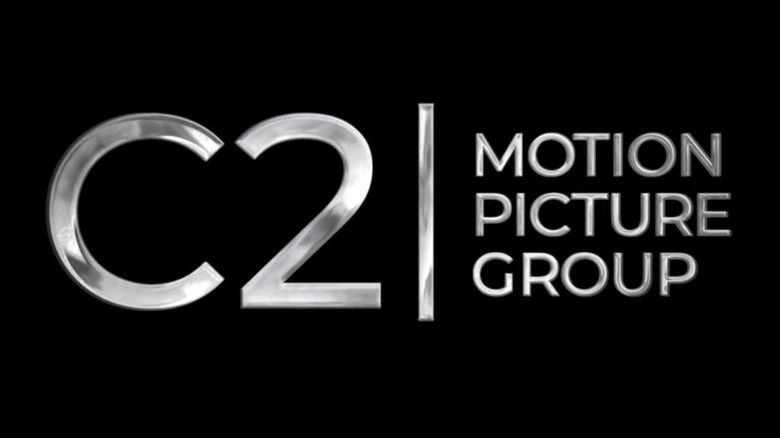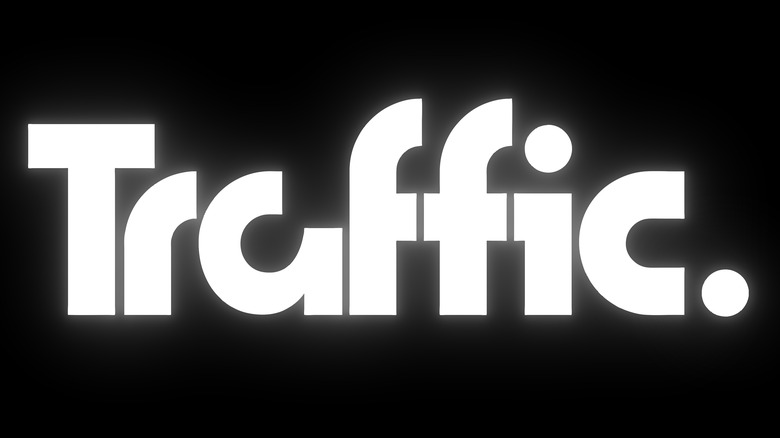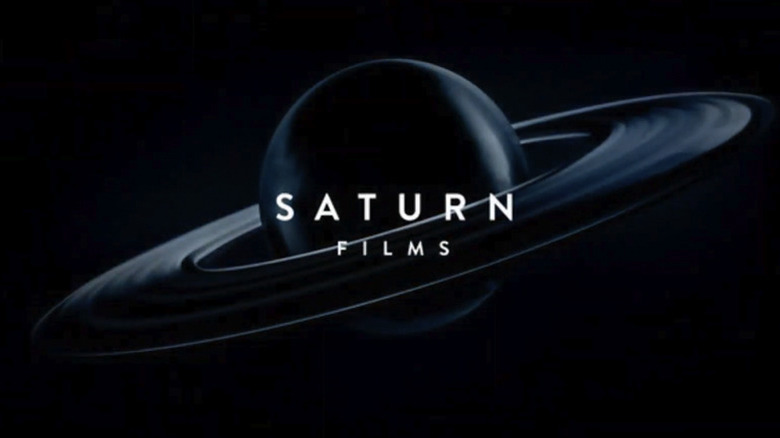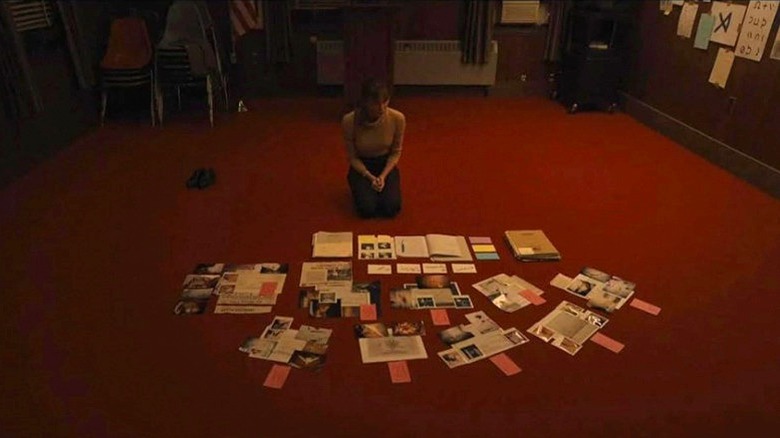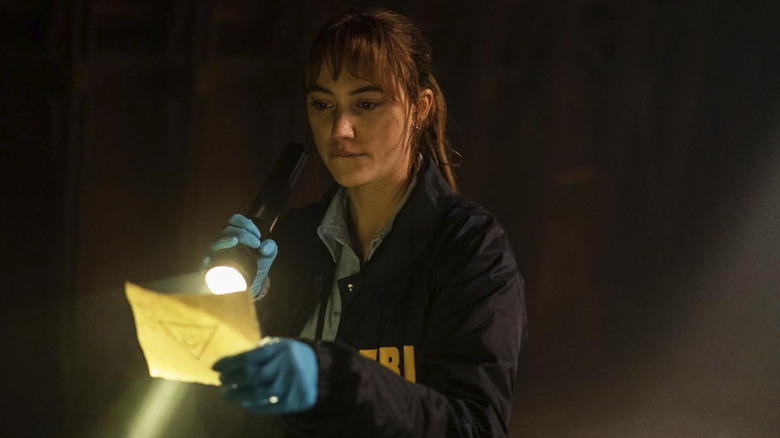Why Are There So Many Company Logos In Front Of Movies? Film Producers Explain [Exclusive]
When you settle in to watch a movie, you're likely expecting to see a studio distributor's logo — Universal, Disney, etc. — and maybe a couple of production company logos pop up before the opening credits begin. But sometimes, the number of those logos can balloon to comical levels, almost as if the movie is pranking you. Julia Ducournau's 2021 movie "Titane" has seven logos in front of it, while "Late Night with the Devil," released earlier this year, has nine. "Family Guy" parodied this phenomenon back in 2011, in the Season 9 episode "Friends of Peter G."
Earlier this year, a listener of our /Film Daily podcast wrote in to ask us about "Longlegs," writer/director Osgood "Oz" Perkins' buzzy horror flick that came out this past summer and shocked Hollywood by becoming the biggest indie horror hit in a decade. When we reference "Longlegs," this listener said, we typically refer to it as a Neon film. But what about all of the other companies that are listed before the film? What did each of them do to earn those logo placements?
Despite covering movies professionally for more than 15 years, I realized I couldn't actually answer that question on my own. Sure, I had made assumptions about what some of those companies might have done, but I couldn't say with certainty that X company did one thing while Y company did another.
"Longlegs" features five logos before the film properly starts: Neon, C2 Motion Picture Group, Traffic., Range Media Partners, and Saturn Films. I reached out to representatives from each of them to ascertain how they contributed, and to answer the larger question of why there are so many production company logos in front of indie films these days. We've already answered the question of what movie producers actually do, so this article will try to break down how each company (and a couple others) helped bring this movie to life.
However, I quickly learned that for an independent project like this, their contributions can't be easily categorized.
Neon
Neon is the first logo that appears when "Longlegs" begins. The company, which also released movies like the Sydney Sweeney nun horror film "Immaculate" and Sean Baker's "Anora," served as the distributor here and also executive produced the film. Deadline reported that at the European Film Market in early 2023, Neon paid multiple millions of dollars to acquire the rights to distribute the movie.
Brian Kavanaugh-Jones, a producer we'll talk more about momentarily, explained how Neon came aboard:
"They bought it off of a minute and a half of footage at Berlin, I think [...] Plenty of times where you go to a distributor like Neon or A24 or IFC or any of the independents, or Netflix, you sell a finished movie. This was not that. This was, '"Holy s***, we love this minute and a half of footage' — which, having done this for a long time, a minute and a half of footage can lie to you. You could buy in and then be like, 'What is this?' I think the joy of it was Neon really knew the filmography of Oz Perkins and were huge believers in that, and [they] also got to see just a hint of Nic Cage in this astounding role and read the script and had done all their homework and came in a really smart way to preempt the market and not let anybody else buy it. It obviously worked out, but I will say that the magic of Neon and our group, all of the producers and financiers and that process, was a really exceptional alchemy to the outcome that we had."
C2 Motion Picture Group
C2 Motion Picture group, a company run by Dave Caplan, financed "Longlegs." Hearing that, it might be easy to assume Caplan and his team just put up the money and maybe checked in here and there on the movie's progress, but that couldn't be further from the truth.
"We kind of operate like a mini studio," Caplan told me about C2. "So we oversee production, we give creative input — creative input on the script, creative input on scenes, and we're one of the creative producers on it in the same way that every producer is on it. I think certain producers are more on the ground every single day. I'm not on the ground every single day, but I'm watching the dailies every day and interfacing with Oz and the other producers." He also pointed out that he has a slightly different perspective than some of his colleagues, since another part of his job is to essentially supervise everything and make sure the film remains on budget and on schedule.
All of the producers I talked to for this piece spoke extremely highly of each other, which doesn't always happen — especially in a creative environment where strong personalities are thrown together and egos can loom large.
"The great news is there are many times where these independent movies come together and there are like 85 producers and there are real conflicted, complicated relationships in that process. I would say ['Longlegs' was], in the independent space, an exceptionally smooth process with a lot of people who have a lot of love for each other," said Kavanaugh-Jones. Talking specifically about C2's involvement, he added, "I think there are lots of financiers that just strictly are the money, but I think Dave is absolutely a value-add from a creative process and a strategic process and a producorial process."
C2 is not a publicly traded company, but it has investors, so a significant aspect of Caplan's job is protecting their investment by making sure the movie is A) a high quality film, and B) sellable, because this project was made without distribution being secured beforehand. That requires a lot of trust, not only in the writer/director, but also in the other producers to step up and take care of business when needed.
"If you have smart, good, creative producers, then having four or five is actually helpful because there are a lot of different plates spinning in the air at any given time," Caplan said. "So it's like you've got to roll with the punches a little bit and, 'Hey, can you help with this? Can you help with that?'"
Traffic.
Traffic. (with the period included after the word) is the third production company whose logo appears, but Dan Kagan, who runs the company, was actually the first producer on "Longlegs." Before he struck out on his own to become a producer, he worked as an executive at Orion Pictures, where he collaborated with Oz Perkins and Brian Kavanaugh-Jones on Perkins' previous movie, 2020's "Gretel & Hansel." One day, Perkins came to Kagan with a pitch: "The general gist of it, as I remember it, is he was like, 'I want to do a Silence of the Lambs-type story if Hannibal Lecter were to work for the devil.' And I was like, 'Oz, that is a ... huge idea, you've got to write that. We'll get it made. Let's do this."
Once the script was finished, Kagan reached out to Dave Caplan at C2 and got him on board. The next step was figuring out where they could actually shoot the film.
"At that point, we brought on Oddfellows [Entertainment], which doesn't have an animated logo, but they have a production company credit, because Oddfellows is Chris Ferguson up in Vancouver," Kagan said. "For a variety of reasons, it made sense to make it up there. He and Brian have a partnership, and I had done [the remake of] 'Child's Play' with Chris, and also we had done some additional photography on 'Gretel' with Chris. There's a real trust in his abilities to map this production from a physical standpoint."
As the originating producer, Kagan was involved in the movie from start to finish, from development to production on set and all the way through post-production. "My job, as I see it, is really being there as the right hand of the director, creatively," he explained. "Speaking through the scripts, making sure that the performances are right, making sure we're not missing anything — that kind of brass tacks creative conversation. Of course, I'm doing that in tandem with Chris, and [seeing] if we can stretch the budget a little bit to add an additional day or an additional camera or something like that."
Range Media Partners
Brian Kavanaugh-Jones and his producing partner, Fred Berger, were working at a company called Automatik when they got involved with "Longlegs." (Berger has an executive producer credit, while Kavanaugh-Jones was a producer.) Dan Kagan explained that, early in the process, Perkins suggested bringing Kavanaugh-Jones on board since the three of them had worked together before. "And frankly at the time, for myself, I had just started indie producing and we both saw obvious value in Brian being the godfather of all this, to help us with casting and whatever else [the production needed]," Kagan said. By the time the film was in post-production, Automatik merged with Range Media Partners, the fourth company to get their logo in front of "Longlegs."
In addition to being on the ground during production, Kavanaugh-Jones was instrumental in helping to facilitate the casting of Nicolas Cage as the title character.
"I've known Nic Cage's manager for 20 plus years," he told me. "I was an agent with him at CAA. When we started to figure out that we had to cast the movie in order to unlock the financing, unlock the whole process, I said, 'What about Nic Cage?' And Oz got very excited about that. My job as a producer then is to just create an opportunity and an option for him. I'm not going to cast the movie, Oz is going to cast the movie. Oz is going to be the one that then connects with the actor, but I called Mike Nilon, [Cage's] manager, and he got excited about it. He read it overnight, which was really cool, and he handed it to Nic. And Nic read it in, I can't remember, like two days. Sometimes it's 'Waiting for Godot,' right? You're waiting two months for an active read, and then you finally get a pass and you're like, 'Did they ever read it?' Nic read it right away, got really excited, and got on the phone with Oz."
"I don't believe we'd have Nicolas Cage without him," Kagan said of Kavanaugh-Jones. "He oversaw the Neon deal. He was incredibly close with Neon on the conversations about the marketing and everything, and brought Range into that conversation."
We've previously covered this film's masterful marketing campaign, and while I assumed Neon was the only company that concocted and executed that campaign, several of the movie's producers weighed in as well, and Range was an integral part of its success. "One of the reasons that Fred and I merged our company in with Range, what's been pretty phenomenal about it is, when I was thinking about other things we were doing, I brought in our entire audience awareness and digital department to help with the campaign with 'Longlegs,'" Kavanaugh-Jones explained. "I just want to highlight that as something I'm really proud of."
Saturn Films
The fifth production company logo belongs to Saturn Films, Nic Cage's shingle. Production companies that are tied to actors can have varying levels of involvement in a movie; if you've ever heard the term "vanity credit" being thrown around, it's probably been in the context of an actor essentially demanding that they receive a producer credit as a condition of signing onto a movie, only to not actually do the work we traditionally associate with producing.
"It comes down to what each actor is interested in," Kavanaugh-Jones told me. "And I've worked with a lot of them. I worked with Margot Robbie on a project, and she was in the budgeting of the thing and really engaged. I think Nic was really smart about knowing which hat he was wearing and figuring out when and how to do that. He showed up when he was acting and didn't want to talk about anything else other than acting. That role was so intense and so exceptional in its craft and vision, and it was the shared vision between him and Oz, but it was a real crafted thing. And by the way, he had to show up and [get] a lot of makeup. If you're really in it, you're not doing anything else for that bit of it. Was he then involved in the marketing and distribution? A hundred precent. He came on after we had a budget and schedule and a plan [...] But Nic has produced forever. I know that on other Saturn movies, he's been involved from development to distro. So this was, he came on after the fact. It was not a vanity credit. He was very involved from a craft perspective and an engagement perspective and a notes perspective, but also from a — the movie doesn't get made without Nic."
Dan Kagan agreed. "Nic was instrumental in getting this movie greenlit because an actor of his stature guarantees a certain budget level and everything else, and he was completely in lockstep with Oz with the creation of the Longlegs character and everything around it."
(Through a representative, Cage himself declined to be interviewed.)
No easy answers
I went into the process of writing this article thinking I would find clear-cut answers about how these folks contributed to the film, but Kavanaugh-Jones disabused me of that notion relatively early in our interview.
"The magic of the group was that everybody had a skillset that they could bring to the process," he said. "I think sometimes it is hard to understand and articulate how across a movie you have to be as a producer and what that looks like. So it's pretty easy, I think, for the narrative to become, from a journalist perspective, like, 'Oh, Dan did this and then Brian did this and then Chris did this, and then Dave did this,' you know what I mean? I want to dispel the idea that there are buckets to that process, because there are not. I'm going line by line through a budget with Chris while he's calling to figure out how to make sure that the [production assistants] are in the right position to do [what they need to do]. It's you're just constantly like, 'Oh my God, what's the next hat to put on? And how do I make sure that the ship stays on track?'"
Additional companies that helped bring Longlegs to life
Depending on the film, there might also be additional production companies involved that don't rise to the level of having their logo play on screen before the action begins. Such was the case with "Longlegs," which had three more companies involved in getting it out into the world: Oddfellows Entertainment, Waypoint Entertainment, and Black Bear.
We've mentioned Oddfellows already: Chris Ferguson was the producer on the ground who organized the locations, wrangled production assistants, and generally made sure the movie was a well-oiled machine when it came to shooting. Kagan described Oddfellows' role as "overseeing the physical side of it, making sure you're not going over budget, making sure you're hiring the right people."
Waypoint Entertainment, on the other hand, has a financial partnership with Neon to, as a press release declared, "deliver a slate of bold genre-spanning films for savvy theatrical audiences that often get overlooked by studios and streamers." I reached out to someone there, but they said it "makes more sense to connect with some other producers" for the purposes of this piece. A source close to the film made it clear to me that Waypoint did not actually produce this movie; according to the source, Waypoint's involvement was purely monetary, and their financing deal with Neon contributed to the advertising and release of the movie.
And finally, Black Bear is a production/finance/distribution company that has distribution arms in the United Kingdom and Canada. C2 fully funded the movie, but Black Bear served as the international sales agent, pre-selling it to dozens of other territories outside of the US, UK, and Canada during the final weeks of filming. "[Black Bear's] John Friedberg and Llewellyn [Radley] and those folks, they are the lifeblood of getting these movies made in the independent space," Kavanaugh-Jones said. "They're the folks that help you make independent financiers feel confident and comfortable taking the bets that they have to take."
The future of indie film producing will likely involve more of this type of collaboration
As we wrapped up our conversation, I asked Kavanaugh-Jones if he thought the era of five, six, or seven production companies coming together to bring a film to life will continue, and he explained that in the indie space, that level of collaboration is often a necessity to get a movie across the finish line.
"Oftentimes, these things take a village," he said. "Even more in the independent space than the studio space, because you have less support and you need just to make the train move. You're pushing the train. At a studio, the train is moving, you get to be a part of it, or you brought it in and they help you start the train. In the independent space, sometimes you're just looking for fuel and you're like, 'Oh my God, I don't have any fuel.' 'Nic Cage is going to provide fuel.' 'This is incredible.' 'Oh my God, Dan Kagan developed this thing that I've fallen in love with, I think I can provide fuel to that, and then Chris is going to help us make it at the right price.' [...] Inevitably because you're sitting in this car without gas, it always becomes a necessity to say, 'Okay, how do we get to the next step?'"
